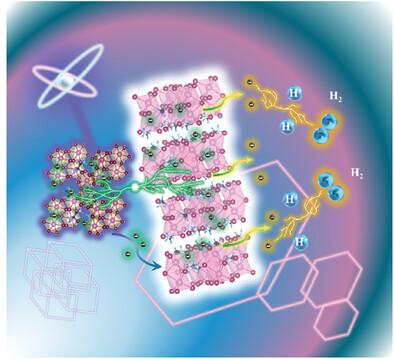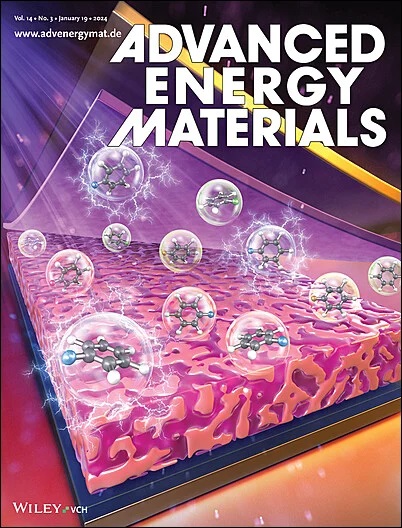Unlocking Interfacial Interactions of In Situ Grown Multidimensional Bismuth-Based Perovskite Heterostructures for Photocatalytic Hydrogen Evolution
IF 24.4
1区 材料科学
Q1 CHEMISTRY, PHYSICAL
引用次数: 0
Abstract
To combat the energy crisis and environmental pollution, developing renewable energy technology such as hydrogen (H2) production is necessary. The sulfur–iodine thermochemical cycle has high commercial potential in conducting hydrogen iodide (HI) splitting for H2 generation, but it requires high-temperature conditions. In comparison, photocatalytic HI splitting of halide perovskites is non-polluted and low-cost for H2 production at room temperature. Herein, an in situ constructed multidimensional bismuth (Bi)-based 3D/2D EDABiI5/MA3Bi2I9 perovskite heterojunction is developed first by synergistically integrating dimensionality control with heterostructure engineering. Accordingly, the optimal EDABiI5/MA3Bi2I9 without any co-catalysts exhibits the H2 evolution rate of 213.63 µmol h−1g−1 under irradiation. Equally importantly, interfacial dynamics of solid/solid and solid/liquid interfaces play a crucial role in photocatalytic performance. Therefore, using temperature-dependent transient photoluminescence and electrochemical voltammetric techniques, it is confirmed that the exciton transportation of EDABiI5/MA3Bi2I9 is accelerated by stronger electronic coupling arising from an enhanced overlap of electronic wavefunctions. Moreover, the effective diffusion coefficient and electron transfer rate of EDABiI5/MA3Bi2I9 demonstrate efficient heterogeneous electron transfer, resulting in improved photocatalytic hydrogen production. Consequently, the in situ formation of perovskite heterostructures studied by a combination of photophysical and electrochemical techniques provides new insights into green hydrogen evolution and interfacial interaction dynamics for commercial applications of solar-to-fuel technology.

揭示原位生长多维铋基过氧化物异质结构的界面相互作用,促进光催化氢气转化
为了应对能源危机和环境污染,有必要开发氢气(H2)生产等可再生能源技术。硫-碘热化学循环在进行碘化氢(HI)分裂以产生 H2 方面具有很高的商业潜力,但它需要高温条件。相比之下,卤化物过氧化物的光催化碘化氢分裂在室温下生产 H2 无污染且成本低。在本文中,通过将尺寸控制与异质结构工程协同整合,首先开发了一种原位构建的多维铋(Bi)基三维/二维 EDABiI5/MA3Bi2I9 包晶异质结。因此,在不使用任何助催化剂的情况下,最佳 EDABiI5/MA3Bi2I9 在辐照条件下的 H2 演化率达到 213.63 µmol h-1g-1。同样重要的是,固/固和固/液界面的界面动力学对光催化性能起着至关重要的作用。因此,利用与温度相关的瞬态光致发光和电化学伏安技术证实,EDABiI5/MA3Bi2I9 的激子传输因电子波函数重叠增强而产生更强的电子耦合而加速。此外,EDABiI5/MA3Bi2I9 的有效扩散系数和电子转移率显示出高效的异质电子转移,从而提高了光催化制氢能力。因此,结合光物理和电化学技术研究的过氧化物异质结构的原位形成,为太阳能转化为燃料技术的商业应用提供了绿色氢演化和界面相互作用动力学的新见解。
本文章由计算机程序翻译,如有差异,请以英文原文为准。
求助全文
约1分钟内获得全文
求助全文
来源期刊

Advanced Energy Materials
CHEMISTRY, PHYSICAL-ENERGY & FUELS
CiteScore
41.90
自引率
4.00%
发文量
889
审稿时长
1.4 months
期刊介绍:
Established in 2011, Advanced Energy Materials is an international, interdisciplinary, English-language journal that focuses on materials used in energy harvesting, conversion, and storage. It is regarded as a top-quality journal alongside Advanced Materials, Advanced Functional Materials, and Small.
With a 2022 Impact Factor of 27.8, Advanced Energy Materials is considered a prime source for the best energy-related research. The journal covers a wide range of topics in energy-related research, including organic and inorganic photovoltaics, batteries and supercapacitors, fuel cells, hydrogen generation and storage, thermoelectrics, water splitting and photocatalysis, solar fuels and thermosolar power, magnetocalorics, and piezoelectronics.
The readership of Advanced Energy Materials includes materials scientists, chemists, physicists, and engineers in both academia and industry. The journal is indexed in various databases and collections, such as Advanced Technologies & Aerospace Database, FIZ Karlsruhe, INSPEC (IET), Science Citation Index Expanded, Technology Collection, and Web of Science, among others.
文献相关原料
| 公司名称 | 产品信息 | 采购帮参考价格 |
|---|
 求助内容:
求助内容: 应助结果提醒方式:
应助结果提醒方式:


